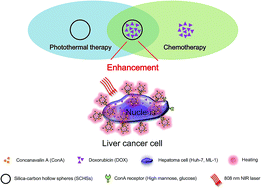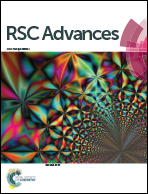Chemo-photothermal effects of doxorubicin/silica–carbon hollow spheres on liver cancer†
Abstract
Chemo-photothermal therapy, which exhibits synergistic effects, is more effective than either of the treatments administered alone because of its superior ability to target and destroy cancer cells. An anti-cancer compound (doxorubicin, DOX) was embedded in silica–carbon hollow spheres (SCHSs) using heat and vacuum to integrate multi-therapeutic effects onto one platform and subsequently improve the anti-cancer efficacy. SCHSs were synthesized via a surface activation method and its highly porous surface enhanced the loading content of the desired drug. SCHSs are an infrared photothermal material that can destroy targeted cells by heating under near-infrared (NIR) laser illumination at 808 nm. NIR laser illumination also enhances DOX release from SCHSs to increase the anti-cancer efficiency of DOX–loaded SCHSs (DOX–SCHSs) in both two-dimensional and three-dimensional multicellular tumor spheroid cultures. SCHSs exhibited high heat-generating ability and pH-responsive drug delivery. In conclusion, this study demonstrated that DOX–SCHSs represent a potential tool for chemo-photothermal therapy due to its photothermal effects. Thus, our findings imply that the high cancer cell killing efficiency of DOX–SCHSs induced by NIR illumination can be used for the treatment of tumors.



 Please wait while we load your content...
Please wait while we load your content...